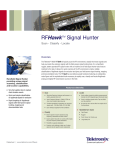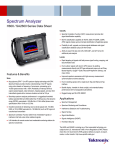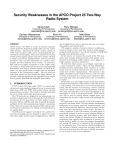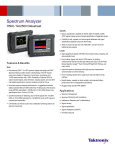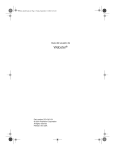Download SA2600 Real-Time Spectrum Analyzer
Transcript
SA2600 Real-Time Spectrum Analyzer Handheld Real-Time spectrum analyzer with DPX™ technology providing live RF view of the spectrum ■ ■ ■ 100% POI for transients with a minimum duration of 500 microseconds The SA2600 handheld real-time spectrum analyzer is ideal for a wide variety of applications, ranging from small radio repair depots, to spectral interference management in the field. Featuring true real-time DPX™ capability in a handheld spectrum analyzer, the SA2600 offers practical solutions to discover short transient spectral events that slip past conventional spectrum and batch processing vector signal analyzers. The portability allows easy instrument sharing in the laboratory environment and robust all-day battery operation in the field, all with the largest display in its class. With field-ready, rugged hardware featuring outstanding displayed average noise level (DANL), spurious free dynamic range (SFDR), phase noise and easy LAN networking capability in a portable unit, the SA2600 is a great choice for general purpose spectrum measurements. Features & Benefits ■ Discover ■ Locate ■ Revolutionary DPX™ spectrum processing provides intuitive understanding of live RF signals using colors based on frequency of occurrence, displaying 2,500 spectrums per sec with a 100% POI for transients with a minimum duration of 500 microseconds ■ Find outdoor signals by plotting measurements directly onto GPS-integrated maps ■ Find in-building signals with a Tap-and-Walkand-Tap interface using maps ■ Integrated mapping solution allows on-site analysis of difficult problems Rapid in-field detection and location of elusive and intermittent signals Rugged handheld platform optimized for field use ■ ■ Datasheet | www.tektronix.com/SA2600 Input Frequency Range 10kHz-6.2GHz to cover most modern signal sources Unsurpassed ability to detect very low level signals with -153dBm DANL at 10 Hz RBW ■ Ready for the Field ■ Benchtop spectrum analyzer performance in a ruggedized handheld battery-operated field unit ■ Intuitive Windows CE-based touch screen intuitive interface designed for field conditions ■ Backlit display, viewable in direct sunlight ■ Extended battery performance with hot-swappable dual batteries Datasheet | SA2600 Real-Time Spectrum Analyzer The SA2600 has a variety of unique features such as visual and audio signal strength indicators and integrated GPS measurements’ mapping with direction-finding vectors for easy location of signal emitters. Having 100% probability of intercept for signals of 500 microseconds or greater, and crystal-clear spectrograms, the SA2600 is an ideal tool for surveying the RF spectrum, mapping received signal strength and resolving spectral interference disputes. It is perfect for engineers doing pre-deployment analyses, signal strength mapping or troubleshooting interference, as well as regulatory agencies who need portable measurement capabilities suitable for today’s RF systems. Tektronix SA2600 Real-Time Spectrum Analyzer 2 The SA2600 is designed for general purpose field use in a wide range of frequency bands and modulation types. It incorporates a unique touch-screen interface that allows very fast tuning and zooming in and out on signals, improving operator efficiency when working across a wide range of frequency bands. The SA2600 offers both performance handheld spectrum analysis as well as innovative musthave technologies like DPX™ and GPS mapping at an affordable price. Discover The patented DPX™ spectrum display offers an intuitive live color view of signal transients changing over time in the frequency domain, giving you immediate confidence in the stability of your design or instantly displaying a fault when it occurs. The Live RF spectrum processing engine brings real time analysis of transient events to spectrum analyzers. Performing 2,500 spectrum updates per second, transients as brief as 500 µs can be displayed in the frequency domain. This offers tremendous improvement over swept analysis techniques. Events are color-coded by rate of occurrence onto a bitmapped display, providing unparalleled insight into the behavior of intermittent signals. Scanning the RF spectrum allows users to spot which signal emitters are in the area. New signals with significant power are usually candidates for further analysis. However, weak signals can also be of interest, especially when they are close to strong signals. Of particular interest are signals that are present in the spectrum today but were not there yesterday. Signals can be stored as reference and deviations from this reference can be quickly identified using the trace math feature. The SA2600 makes analysis easier by quickly logging signals that are weak, bursty, hopping, time multiplexed, or intentionally random. It takes advantage of the FFT-based spectrum analysis capability to allow users to see the true shape of the signal, even when it is bursty. Masks can be automatically created from traces captured earlier. You can compare this mask to the current trace and if a mask violation occurs, the trace is logged. Finally, when the spectrogram is paused, you can scroll through the spectrogram’s time-axis and view the results. Figure 1. DPX showing three hopping frequencies Figure 2. Trace math showing signals not present in the reference www.tektronix.com/SA2600 3 Datasheet | SA2600 Real-Time Spectrum Analyzer Locate Once a signal of interest is identified, the SA2600 provides various field-proven signal-hunting tools to locate it. For the easier-to-find signals, the signal strength meter produces audible tones that vary in pitch as a function of the received power. The user can simply point the antenna in the direction that receives maximum power. This allows them to look for signals while watching their surroundings, not the screen. Figure 4. Color-coded measurements for rapid in-field analysis Figure 3. Signal strength for accurate signal finding 4 Harder to find signals, such as those influenced by multipath, fading or low signal strength, the SA2600 provides several signal-mapping tools to facilitate hunting for these signals. Maps can be imported from a variety of formats using the PC-based iMap Converter application. Signal intensity can be directly recorded, and directionfinding arrows can be directly placed on the map by the user to show the directions where the signal intensity is the greatest. Once you are done, you have a record of your work. Figure 5. Locating Interference with integrated mapping solution Analyzing mapped signals is a quick way to locate signals that can be difficult to find otherwise. Traces can be recorded on a map either manually or automatically. Built-in GPS can be used to record signal position and time data as the instrument moves. The mapping functionality works indoors as well. Using the unique “tap-and-walk-and-tap” interface, users tap on the map to indicate a start location for data acquisition. The end location is similarly recorded. The SA2600 captures the data with the initial tap and follows a straight-line to the end tap. It then displays the measurements, equally spaced between these two measurement points. Figure 6. Mapping signals Indoors Ready for the field The SA2600 will quickly scan the RF environment and help you locate the interference sources with its field-proven signal hunting tools. The instrument’s layout is designed in a way that helps reduce the possibility of user mistakes even if the issue is complex. The instrument does not get in your way. The Windows CE-based touch screen interface is designed specifically to enhance productivity and navigation. While other solutions sometimes require offline GPS and mapping software, the SA2600 includes integrated GPS and mapping tools to allow more efficient interference location capability. The extremely rugged, rubberized magnesium alloy case is designed for harsh field environments and can withstand drops and mistreatment. With the optional second battery, the SA2600 provides more than five hours of use for continuous Spectrum Mode. The hot-swappable batteries can dramatically extend the in-field usage time because they can be replaced one at a time. www.tektronix.com/SA2600 5 Datasheet | SA2600 Real-Time Spectrum Analyzer SA2600 Ordering Guide SA2600 Real-Time Spectrum Analyzer with DPX™ and built-in GPS (includes GPS antenna) Standard Accessories SA2600 Quick Start User Manual SA2600 Installation software AC Power Adapter Lithium-Ion Battery GPS Antenna Tilt stand Soft carry case BNC Connector cover (2) N Connector cover (1) Audio jack mute plug (mute all audio output from the instrument speaker) Warranty One year on parts and labor Language Options L0 SA2600 English manual L99 No Manual Power Options Power Options A0 North America A1 Universal EURO A10 China A11 India A2 United Kingdom A3 Australia A5 Switzerland A6 Japan A99 No Power Cord or AC Adapter Service Options CA1 Provides a single calibration event or coverage for the designated calibration interval, whichever comes first. C3 Calibration service - 3 years C5 Calibration service - 5 years D1 Calibration data report D3 Calibration data report 3 years (with Option C3) D5 Calibration data report 5 years (with Option C5) R3 Repair service 3 years (including warranty) R5 Repair service 5 years (including warranty) 6 Suggested Accessories Antenna Beam Antenna, 824 to 896 MHz: Order 119-6594-00 Beam Antenna, 896 to 960 MHz: Order 119-6595-00 Beam Antenna, 1710 to 1880 MHz: Order 119-6596-00 Beam Antenna, 1850 to 1990 MHz: Order 119-6597-00 Sniffer (Whip) antenna – Wideband (5 MHz to 1080 MHz) : Order 119-6609-00 (needs adapter 103-0045-00) Magnetic Mount Antenna, 824 to 2170 MHz: Order 119-6970-00( needs adapter 103-0449-00 Filters Pre-Filter, General Purpose, 824 to 2500 MHz, Type-N (f) Connector – Order 119-7246-00 Pre-Filter, General Purpose, 824 to 6200 MHz, Type-N (f) Connector – Order 119-7426-00 Cables Cable, 50 Ω , BNC (m) 3 foot (91 cm): Order 012-0482-00 Cable, 50 Ω , Straight Type-N(m) and angled Type-N (m) connector, 1.6 foot (50 cm): Order 174-4977-00 Cable, 50 Ω , Type-N (m) to Type-N (m) connector, 3 foot (91 cm): Order 174-5002-00 Misc External Charger: order 119-6030-00 AC Power Supply: order 119-6984-00 DC Vehicle Adapter: order 119-6028-00 Spare Lithium-Ion Battery: order 146-0151-00 Display Protector Sheets (5): order 016-1882-00 Specifications General Performance Characteristics Characteristic Description RF Input Characteristic 10 kHz – 6.2 GHz Maximum Operating Input Level +20 dBm peak envelope power This is the maximum input level at which the instrument will meet its performance specifications. For a signal without any amplitude variation, peak envelope power = rms. 50 W rms below 3.2 GHz 15 W rms between 3.2 GHz and 6.2 GHz Range Setting Resolution Output Impedance 50 ohms IF Center Frequency 140 MHz IF 3 dB Bandwidth 24 MHz Range Setting Resolution External Reference Input Impedance 1500 ohms Frequency Range 1 MHz up to 20 MHz ± 1 PPM in 1 MHz steps Input Level Range –15 dBm to +15 dBm, 1 MHz to 15 MHz –10 dBm to +15 dBm, 16 MHz to 20 MHz dBm levels assume 50 ohm source 10 Hz to 3 MHz (Manual RBW) 10 Hz to 1 MHz (Auto RBW) 1 Hz Spectral Purity Phase Noise Internal Timebase ± 0.5 PPM from 0 °C to 50 °C ± 1.0 PPM aging/year Twenty minute warm-up period required to meet accuracy specification 10 kHz to 6.2 GHz, preamp off 10 MHz to 6.2 GHz, preamp on 1 Hz Span Displayed Average Noise Level, Preamp On IF Output Error Description Center Frequency Operating Frequency Range Maximum Input Power without Damage Spectrum Analyzer Characteristics Residual Spurious, Preamp Off Residual Spurious, Preamp On Third Order IMD Second Harmonic Input Related Spurious Input Related Spurious, exception frequencies, typical Third Order Intercept –153 dBm, 10 MHz to 2 GHz, 10 Hz RBW –152 dBm, 2 GHz to 4 GHz, 10 Hz RBW –151 dBm, 4 to 5 GHz, 10 Hz RBW –145 dBm, 5 to 6.2 GHz, 10 Hz RBW Reference Level (DANL + 90 dB) ≤ -95 dBc/Hz @ 10 kHz offset ≤ –95 dBc/Hz @ 20 kHz offset ≤ –95 dBc/Hz @ 30 kHz offset ≤ –97 dBc/Hz @ 100 kHz offset ≤ –110 dBc/Hz @ 1 MHz offset ≤ –90 dBm, 0 dBm attenuator setting Exception frequencies: 9 MHz to 19 MHz center frequency 3464 MHz center frequency 4592 MHz center frequency 5374 MHz to 5378 MHz center frequency 6160 MHz center frequency ≤ –105 dBm, 0 dBm attenuator setting Exception frequencies: 9 MHz to 19 MHz center frequency 5374 MHz to 5378 MHz center frequency ≤ –70 dBc for two tones at or below the reference level, preamp off, all gain settings Auto-coupled ≤ –60 dBc for a single tone at or below the reference level, preamp off, all gain settings Auto-coupled ≤ –70 dBc except for Fin= 2.282 GHz ± 20 MHz The reference for 'dBc' for this specification is the total power of all signals present at the input of the instrument regardless of the current span ≤ –55 dBc except for Fin= 2.282 GHz ± 20 MHz The reference for “dBc” for this specification is the total power of all signals present at the input of the instrument regardless of the current span ≥ +7 dBm, 0 dB Input Attenuation, Preamp Off www.tektronix.com/SA2600 7 Datasheet | SA2600 Real-Time Spectrum Analyzer Spectral Display Amplitude Reference Level Range Marker Power Accuracy General Purpose RF Measurements Characteristics +20 dBm to –160 dBm Characteristic Description ±1.75 dB, –50 dBm ≤ input ≤ +20 dBm, preamp off ±3.0 dB, –80 dBm ≤ input < –50 dBm, preamp on, above 10 MHz ±3.75 dB, –120 dBm ≤ input < –80 dBm, preamp on, above 10 MHz Use peak detector for CW-like signals; use average detector for wideband (signal >> RBW) Accuracy guaranteed for CW signals and span set to 20 MHz or less General Purpose RF Channel Power Measurement Display Accuracy Normal - updates display with each new result Max Hold - updates displayed point only if new point > old Min Hold - updates displayed point only if new point < old Max/Min Hold - displays a vertical bar between Max Hold and Min Hold Average - displays average of N (specified by user) acquisitions Display Modes Average is calculated as follows: Last N values are saved in memory; when a new result is available, the earliest result of the N stored values is discarded, the new result is added to the stored values, and a new average is calculated from the stored values If the number of results is less than N, then all of the results are averaged together Number of Averages Measurement Bandwidth Range 1 ≤ N ≤ 200 1 kHz - 20 MHz ≤ 1.2 dB; +20 dBm to –60 dBm; Resolution BW < 100 kHz +20 dBm to –40 dBm; Resolution BW ≥ 100 kHz 1 MHz to 3.2 GHz , preamp off ≤ 2 .4 dB; –60 dBm to –75 dBm; Resolution BW < 100 kHz –40 dBm to –55 dBm; Resolution BW ≥ 100 kHz 10 MHz to 3.2 GHz , preamp on ≤ 1.8 dB; +20 dBm to –50 dBm; Resolution BW < 100 kHz +20 dBm to –40 dBm; Resolution BW ≥ 100 kHz 3.2 GHz to 6.2 GHz , preamp off ≤ 3 dB; –50 dBm to –75 dBm; Resolution BW < 100 kHz –40 dBm to –55 dBm; Resolution BW ≥ 100 kHz 3.2 GHz to 6.2 GHz , preamp on Specifications apply for default control settings (Auto RBW, Auto Level) Occupied Bandwidth Measurement Percent Power Inclusion Range 50% - 100% RF Field Strength Channel Same as Channel Power Bandwidth Range Accuracy Same as Channel Power DPX™ Measurements Processing Characteristics Characteristic Description Spectrum Processing Rate, nominal 2,500 per second (span independent) Min Signal Duration for 100% Probability 500 µs of Intercept, typical Span Range Mapping Native Map Type Graticule (.gsf) Map types directly supported MapInfo (*.mif) Bitmap (*.bmp) Other Map types accepted using PC application iMap Converter MapInfo (*.mif) Bitmap (*.bmp) Other raster formats (*.gif, *.jpg, *.png, *.tif) Google Earth Microsoft MapPoint USGS DLG (*.opt) ESRI ArcInfo Shape (*.shp) 20 kHz to 20 MHz Battery Life 5 hours of continuous Spectrum Mode (with optional second battery). Actual life can be higher depending on usage. 8 Physical characteristics Signal Analysis and Monitoring Characteristics Characteristic Description Characteristic Description AM Demodulation Provides an audio output signal after AM demodulation of the user-selected signal Dimensions Height: 25.5 cm. (10.0 in) Width: 33 cm. (13 in) Depth: 12.5 cm. (4.8 in) Weight 5.56 kg (12.27 lbs) Measurement Frequency As previously selected Minimum Input Signal Level, Typical -100 dBm Audio Measurement Bandwidth 8 kHz Provides an audio output signal after FM demodulation of the user-selected signal FM Demodulation Measurement Frequency As previously selected Minimum Signal Level, Typical -100 dBm Maximum Signal Deviation Up to 100 kHz Audio Measurement Bandwidth 8 kHz, 15 kHz, 75 kHz, or 200 kHz Maximum Audio Output Bandwidth 15 kHz Provides both an audio tone and a visual display that are related to the strength of the user selected signal Signal Strength Indicator Input Signal Level -120 dBm, minimum Measurement Frequency As previously selected Measurement Bandwidth Up to 20 MHz, dependent upon span and RBW setting Tone Type Variable beep rate or variable frequency Update Rate, Typical 10 per second Display characteristics Characteristic Description Color Display 10.4 in. (diagonal), transflective LCD Resolution: 640x480 (VGA) Miscellaneous characteristics Characteristic Description Recommended Instrument Calibration Interval 2 years Safety compliance Characteristic ANSI/UL61010-1:2004 Electrical Equipment for Measurement, Control, and Laboratory Use. Environmental characteristics Characteristic Description Temperature Operating: 0 °C to +50 °C specified performance, –10 °C to +50 °C, typical Nonoperating: –40 °C to +60 °C The temperature specs above are modified with the following options installed: Li-Ion Batteries: Charge 0 °C to +45 °C, Storage –20 °C to +60 °C Humidity Operating and Nonoperating: 5% to 95% relative humidity (RH) at up to +30 °C, 5% to 45% RH above +30 °C up to +50 °C, noncondensing Altitude Operating: Up to 4,600 meters (15,092 feet) Nonoperating: Up to 12,192 meters (40,000 feet) Description CSA C22.2 No. 61010.1:2004 Electrical Equipment for Measurement, Control, and Laboratory Use. Safety Compliance EN 61010-1:2001 Electrical Equipment for Measurement, Control, and Laboratory Use. IEC61010-1:2001 Electrical Equipment for Measurement, Control, and Laboratory Use. ISA 82.02.01 Electrical Equipment for Measurement, Control, and Laboratory Use. www.tektronix.com/SA2600 9 Datasheet | SA2600 Real-Time Spectrum Analyzer About Tektronix: For Further Information: Tektronix has more than 60 years of experience in providing network operators and equipment manufacturers a comprehensive and unparalleled suite of network diagnostics and management solutions for fixed, mobile, IP and converged multi-service networks. Tektronix maintains a comprehensive, constantly expanding collection of application notes, technical briefs and other resources to help engineers working on the cutting edge of technology. Please visit www.tektronix.com/communications These solutions support architectures and applications such as fixed mobile convergence, IMS, broadband wireless access, WiMAX, VoIP and triple play, including IPTV. Contact Tektronix: Please visit www.tektronix.com/communications Learn more about Tektronix' communications test, measurement and network monitoring solutions by visiting: www.tektronix.com/communications Phone: 1-800-833-9200 option 1 +1-469-330-4000 Locate your nearest Tektronix representative at: www.tektronix.com/contactus Copyright © Tektronix. All rights reserved. Tektronix products are covered by U.S. and foreign patents, issued and pending. Information in this publication supersedes that in all previously published material. Specification and price change privileges reserved. TEKTRONIX and TEK are registered trademarks of Tektronix, Inc. All other trade names referenced are the service marks, trademarks or registered trademarks of their respective companies. 06/08 | CWW-22258-0










